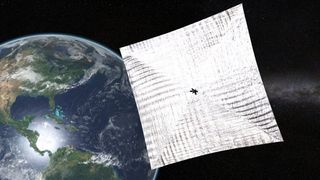Want to See the First Satellite Propelled Solely by the Sun? Here's How.

LightSail 2, The Planetary Society's solar sailing spacecraft, has spent more than two months in orbit.
During that time, the bread-box-sized spacecraft deployed a set of silver Mylar sails and began to climb, proving that the small satellite can raise its orbit without a drop of conventional fuel. Propelled solely by the power of the sun, the spacecraft has shown that solar sailing may be a viable means of propulsion.
With LightSail 2's primary mission complete, the rest of the spacecraft's time in orbit — about a year, all told — provides a great chance for folks around the world to glimpse the spacecraft for themselves. According to Bill Nye "The Science Guy" and his team at The Planetary Society, skywatchers around the world can spot the spacecraft as it glides above Earth — if the conditions are just right.
Related: A Solar Sail in Space: See the Awesome Views from LightSail 2
Here's how you can spot it as it passes overhead.
Because LightSail 2's shiny sails are so large (roughly the size of a boxing ring), the spacecraft should be visible to the naked eye in many parts of the world, appearing as a faint star-like object that takes just a few minutes to glide across the sky.
The best times to spot the spacecraft will be at dusk and dawn, when the sun is below the horizon yet still shining where LightSail 2 is orbiting. But a sighting isn't guaranteed; the trick is knowing when and where to look up.
Get the Space.com Newsletter
Breaking space news, the latest updates on rocket launches, skywatching events and more!
Your chances of seeing LightSail 2 depend greatly on the satellite's orientation, Jason Davis, a digital editor at The Planetary Society, told Space.com in an email. If the sail is edge-on to your vantage point, you won't be able to see it. However, if the sails are oriented just so, so the sun shines off the sails, LightSail 2 will appear as bright as a star in the night sky.
Skywatchers can visit the mission's website for a map showing LightSail 2's current position. Here, you can also track the next time the spacecraft is expected to be in range of your location.
Because the satellite isn't always easy to spot, observers may want to check out N2YO.com (a tracking website that provides the location data to The Planetary Society) for a more detailed report. This website shows when LightSail 2 should be visible from a given location over the next 10 days. The site also offers an estimate for how likely you are to actually see the satellite during a given pass.
If you want to try catching LightSail 2, make sure to go outside before the start of the pass, to allow your eyes time to adjust to the darkness. The spacecraft appears as a faint pinprick gliding across the night sky, so don't be too disappointed if you don't spot it on the first try.
The tiny satellite is expected to continue sailing around Earth for about a year before it is deorbited, so keep looking up.
- New LightSail 2 Spacecraft Will Boost Solar-Sailing Interplanetary Missions
- Sailing on Sunbeams: Planetary Society's LightSail 2 to Soar Higher Than Space Station
- LightSail 2 Beams 1st Photos Home from Orbit! How to Track the Little Satellite
Follow Amy Thompson on Twitter @astrogingersnap. Follow us on Twitter @Spacedotcom or Facebook.

Join our Space Forums to keep talking space on the latest missions, night sky and more! And if you have a news tip, correction or comment, let us know at: community@space.com.

Amy Thompson is a Florida-based space and science journalist, who joined Space.com as a contributing writer in 2015. She's passionate about all things space and is a huge science and science-fiction geek. Star Wars is her favorite fandom, with that sassy little droid, R2D2 being her favorite. She studied science at the University of Florida, earning a degree in microbiology. Her work has also been published in Newsweek, VICE, Smithsonian, and many more. Now she chases rockets, writing about launches, commercial space, space station science, and everything in between.
